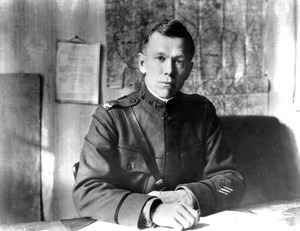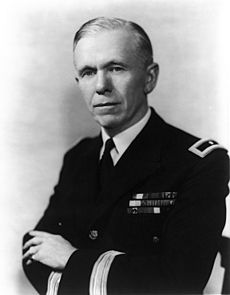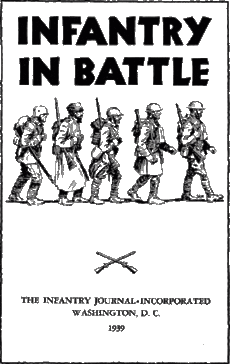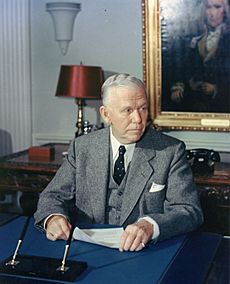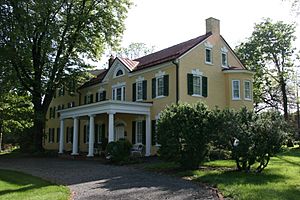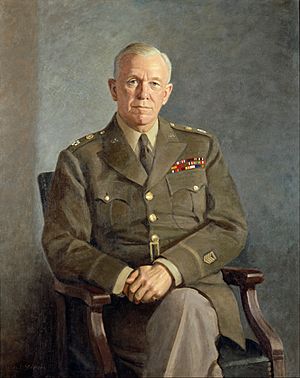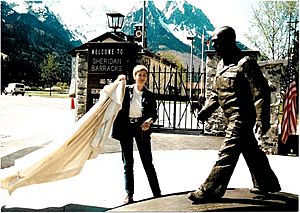George C. Marshall facts for kids
Quick facts for kids
George C. Marshall
|
|
|---|---|
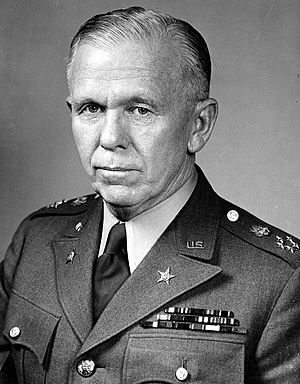
Official portrait, 1946
|
|
| 3rd United States Secretary of Defense | |
| In office September 21, 1950 – September 12, 1951 |
|
| President | Harry S. Truman |
| Deputy | Stephen Early Robert A. Lovett |
| Preceded by | Louis A. Johnson |
| Succeeded by | Robert A. Lovett |
| 10th President of the American Red Cross | |
| In office October 1, 1949 – December 1, 1950 |
|
| President | Harry S. Truman |
| Preceded by | Basil O'Connor |
| Succeeded by | E. Roland Harriman |
| 2nd Chairman of the American Battle Monuments Commission | |
| In office January 1949 – October 16, 1959 |
|
| Preceded by | John J. Pershing |
| Succeeded by | Jacob L. Devers |
| 50th United States Secretary of State | |
| In office January 21, 1947 – January 20, 1949 |
|
| President | Harry S. Truman |
| Deputy | Dean Acheson Robert A. Lovett |
| Preceded by | James F. Byrnes |
| Succeeded by | Dean Acheson |
| United States Special Envoy to China | |
| In office December 20, 1945 – January 6, 1947 |
|
| President | Harry S. Truman |
| Preceded by | Position established |
| Succeeded by | Position abolished |
| 15th Chief of Staff of the United States Army | |
| In office September 1, 1939 – November 18, 1945 |
|
| President | Franklin D. Roosevelt Harry S. Truman |
| Deputy | Lorenzo D. Gasser |
| Preceded by | Malin Craig |
| Succeeded by | Dwight D. Eisenhower |
| Personal details | |
| Born |
George Catlett Marshall
December 31, 1880 Uniontown, Pennsylvania, U.S. |
| Died | October 16, 1959 (aged 78) Walter Reed Army Medical Center Washington, D.C., U.S. |
| Resting place | Arlington National Cemetery |
| Political party | None |
| Height | 6 ft (183 cm) |
| Spouses |
Lily Carter Coles
(m. 1902; died 1927)Katherine Boyce Tupper Brown
(m. 1930) |
| Education | Virginia Military Institute |
| Civilian awards | Nobel Peace Prize Congressional Gold Medal Charlemagne Prize Complete list |
| Signature |  |
| Military service | |
| Branch/service | United States Army |
| Years of service | 1902–1959 |
| Rank | |
| Commands | Chief of Staff of the United States Army Deputy Chief of Staff of the United States Army 5th Brigade, 3rd Infantry Division Fort Moultrie and District I, Civilian Conservation Corps Fort Screven and District F, Civilian Conservation Corps 8th Infantry Regiment |
| Battles/wars | |
| Military awards | Army Distinguished Service Medal (2) Silver Star Croix de Guerre Complete list |
| College football career | |
| VMI Keydets | |
| Position | Left Tackle |
| Career history | |
| College | VMI (1900) |
| Career highlights and awards | |
|
All-Southern (1900)
|
|
George Catlett Marshall Jr. (December 31, 1880 – October 16, 1959) was an important American army officer and leader. He became the Chief of Staff of the U.S. Army during World War II under Presidents Franklin D. Roosevelt and Harry S. Truman. After the war, he served as Secretary of State and Secretary of Defense.
Winston Churchill, a famous British leader, called Marshall the "organizer of victory" for his role in helping the Allied forces win World War II. After the war, Marshall tried to help bring peace to China, but it was a difficult task. As Secretary of State, he created the Marshall Plan. This plan helped European countries rebuild their economies after the war. For this important work, he won the Nobel Peace Prize in 1953.
Contents
- Early Life and Education
- Early Military Career
- World War I Service
- Between the World Wars
- World War II Leadership
- After the War: China and Secretary of State
- Secretary of Defense and Korean War
- Later Life and Legacy
- Images for kids
- Fictional Portrayals
- Dates of Rank
- Awards and Decorations
- Honorary Degrees
- See also
Early Life and Education
George Catlett Marshall Jr. was born in Uniontown, Pennsylvania. He was the youngest of three children. His family had strong roots in Virginia and Kentucky. Marshall's father worked in the coal business.
Marshall decided early on that he wanted to be a soldier. He attended the Virginia Military Institute (VMI) starting in 1897. His brother thought he wouldn't succeed, but Marshall was determined. His mother sold land to help pay for his schooling.
At VMI, Marshall was excellent in military training. He became the highest-ranking cadet. He also played football as an offensive tackle. In 1901, he graduated from VMI.
Early Military Career
After VMI, Marshall worked at a military school in Danville, Virginia. He passed a test to become an officer in the U.S. Army. In 1902, he became a second lieutenant in the Infantry. Soon after, he married Lily Carter Coles and went to serve in the Philippines.
Before World War I, Marshall had many different jobs in the Army. He served as a platoon leader and company commander in the Philippines. He learned a lot about modern warfare. He was a top graduate from the Army's Infantry-Cavalry School in 1907. He also finished first in his Army Staff College class in 1908.
In 1916, Marshall became an assistant to Major General J. Franklin Bell. Bell was a former Army chief of staff. When the U.S. entered World War I in 1917, Marshall helped prepare the 1st Division for war in France.
World War I Service
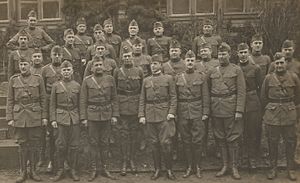
During World War I, Marshall helped plan training and combat operations. He worked with the 1st Division in France. He even walked into dangerous "no-man's land" to scout the area. He was injured during this time but kept working.
Marshall was praised for planning the Battle of Cantigny in May 1918. This was the first major American victory of the war. Later, he joined the staff of the American Expeditionary Forces (AEF). He helped plan the Meuse-Argonne Offensive, which was a key battle that helped defeat Germany.
By the end of the war, Marshall was a temporary colonel. He was even recommended for promotion to brigadier general. After the war, he became chief of staff for the U.S. Eighth Corps.
Between the World Wars
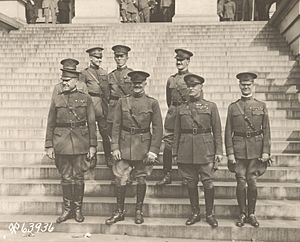
After World War I, Marshall became an assistant to General John J. Pershing. He worked on projects to train soldiers for modern warfare. He also served in China for three years. There, he learned some basic Mandarin.
In 1927, Marshall became assistant commandant of the Army's Infantry School. He made important changes to how the Army trained its leaders. These changes were very helpful during World War II. He also helped create Infantry in Battle, a training manual still used today.
Marshall's first wife, Lily, died in 1927. In 1930, he married Katherine Boyce Tupper Brown. General Pershing was his best man at the wedding.
During the Great Depression, Marshall supported President Franklin D. Roosevelt's programs. He commanded soldiers and also oversaw Civilian Conservation Corps (CCC) camps. These camps helped young men find work during the Depression. Marshall worked to improve the lives of the men in the CCC camps.
In 1938, Marshall was assigned to the War Plans Division in Washington, D.C. He later became the Army's Deputy Chief of Staff. President Roosevelt chose Marshall to be the Army Chief of Staff. Marshall was sworn in on September 1, 1939, the day Germany invaded Poland, starting World War II. He held this important job until 1945.
World War II Leadership
As Chief of Staff, Marshall led the biggest growth of the U.S. military ever. He took an Army of only 189,000 men and helped it grow to over eight million soldiers by 1942. He worked closely with Secretary of War Henry L. Stimson. Marshall was promoted to five-star rank as General of the Army.
Marshall was a skilled organizer. He was good at inspiring other officers. Many top American generals of the war were chosen or recommended by Marshall. These included Dwight D. Eisenhower and George S. Patton.
Building the Army
Marshall faced the huge task of turning civilians into soldiers. He focused on quickly training many soldiers. However, this fast training sometimes meant soldiers lacked experience. Early in the war, U.S. forces faced challenges against experienced German units.
Marshall had planned for a large Army with units rotating in and out of combat. But by 1943, he changed this plan. He decided to send individual replacements to units already fighting. This system caused problems for soldiers' morale and teamwork. New soldiers often didn't have enough training before going into battle.
Planning the Invasion of Europe
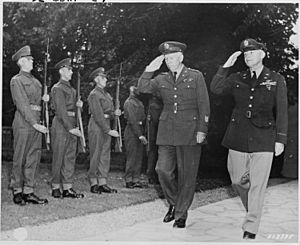
Marshall was key in preparing the U.S. Army and Air Forces for the invasion of Europe. He wrote the main strategy for all Allied operations in Europe. He convinced the United Kingdom to focus on defeating Germany first.
Marshall wanted to be the Supreme Commander of Operation Overlord, the invasion of Europe. But President Roosevelt chose Eisenhower instead. Roosevelt said he couldn't do without Marshall in Washington. He needed Marshall as Chief of Staff.
On December 16, 1944, Marshall became the first American Army general to be promoted to the new rank of General of the Army. This is a five-star rank, like a field marshal.
Marshall coordinated Allied operations in Europe and the Pacific until the war ended. Winston Churchill called him the "organizer of Allied victory." Time magazine named Marshall "Man of the Year" in 1943. Marshall officially left his Chief of Staff role in November 1945.
After the War: China and Secretary of State

In December 1945, President Harry S. Truman sent Marshall to China. Marshall's job was to help stop the Chinese Civil War. He tried to create a shared government between the Nationalists and the Communists. But both sides refused his ideas. He returned to the U.S. in 1947.
Truman then appointed Marshall as Secretary of State. Marshall was a respected leader. He became the voice for plans to rebuild Europe.
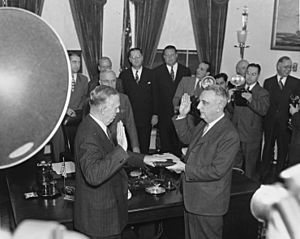
On June 5, 1947, Marshall gave a famous speech at Harvard University. He explained the American plan to help Europe recover. This plan became known as the Marshall Plan. It helped European countries rebuild their economies. Time magazine named Marshall "Man of the Year" again in 1948.
Marshall resigned as Secretary of State in January 1949 due to health issues. He was very tired from his work. Truman then gave him honorary roles. He became chairman of the American Battle Monuments Commission and president of the American National Red Cross. In 1953, he received the Nobel Peace Prize for his work to help Europe after the war.
Secretary of Defense and Korean War
When the Korean War started, the U.S. military was not ready. President Truman asked Marshall to become Secretary of Defense in September 1950. Congress had to make a special exception for this, as a military officer usually couldn't hold this job. Marshall was the first to receive such an exception.
Marshall's main goal was to restore confidence in the military. He also worked to rebuild the armed forces after World War II. He brought in new leaders to help him. He also improved the relationship between the Defense and State Departments.
Marshall supported General Douglas MacArthur's plans in Korea. However, MacArthur made public statements that went against President Truman's war plans. This caused a big problem.
On April 6, 1951, Truman met with Marshall and other leaders. They discussed whether MacArthur should be removed. Marshall agreed that MacArthur's removal was necessary. This was to ensure that civilian leaders controlled the military. On April 11, 1951, Truman removed MacArthur from his command.
Later Life and Legacy
In September 1951, Marshall retired after 49 years of public service. He moved to his home, Dodona Manor, in Leesburg, Virginia. He and his wife Katherine enjoyed gardening there. Katherine loved roses so much that a new rose was named after her.
Marshall continued to serve as chairman of the American Battle Monuments Commission. He oversaw the building of cemeteries in other countries for soldiers killed in World War II.
In June 1953, Marshall led the American group to the coronation of Queen Elizabeth II. People stood up for him as he walked into Westminster Abbey. He was the only non-royal person seated at the Queen's table at the banquet.
Marshall died in Washington, D.C., on October 16, 1959. He was buried with honors at Arlington National Cemetery. He was buried next to his first wife and her mother. His second wife was also buried there later.
Marshall's Reputation
Historians see George Marshall as a very important and selfless American leader. He was known for being honest and having strong integrity. He was an excellent military organizer and planner. Even early in his career, his superiors recognized his great potential.
After World War II, Secretary of War Henry L. Stimson called Marshall "the finest soldier I have ever known." Marshall was not afraid to speak his mind, even to powerful people like President Roosevelt. He once told Roosevelt to stop calling the Navy "us" and the Army "them."
Marshall is most famous for the Marshall Plan. This plan gave billions of dollars to help rebuild Europe after the war. This cooperation between former enemies helped lead to the creation of the European Union much later.
President Truman once said that Marshall was the American who made the greatest contribution in his lifetime. He called Marshall a great leader with amazing knowledge of military affairs.
Orson Welles, a famous actor and director, called Marshall "the greatest man I ever met." He said Marshall was a "tremendous gentleman."
Memorials and Tributes
Many places are named after General Marshall. These include streets in Germany. There are also two non-profit groups that work to keep his legacy alive. The George C. Marshall Foundation keeps his papers and documents. The George C. Marshall International Center preserves his home, Dodona Manor, as a museum.
In 1998, the first public statue of General Marshall in Europe was unveiled in Germany. It shows him walking across a bridge, reaching out to new friends and allies.
Images for kids
-
Left to right: Brig. Gen. Frank Parker, Col. James A. Drain, and Lt. Col. George C. Marshall at the White House in Washington, D.C., on October 4, 1924.
-
Army Chief of Staff George Marshall with Air Force Chief of Staff Gen. "Hap" Arnold accompanying Brig. Gen. James H. Doolittle while being presented the Medal of Honor from President Franklin Roosevelt for his achievement on leading the Doolittle Raid. April 18, 1942.
-
Oveta Culp Hobby being sworn in as the first WAAC by Major General Myron C. Cramer. General George C. Marshall, second from left, and Secretary of War Henry L. Stimson witness the ceremony. May 16, 1942.
-
General Marshall greets Major General John R. Deane and Brigadier General Stuart Cutler while arriving at Potsdam, Germany on July 15, 1945.
-
General Marshall with General of The Air Force Henry H. Arnold and Air Force Major General Lauris Norstad at The Potsdam Conference in Germany, July 21, 1945.
-
Recently sworn in George C. Marshall as the new United States Secretary of State shaking hands with his predecessor James F. Byrnes, as President Truman looks on, at the White House, January 21, 1947.
-
Secretary of State Marshall pointing out landmarks at Mount Vernon to Mexican President Miguel Aleman. April 1947.
-
Secretary of Defense Marshall with President Truman and Princeton University President Harold W. Dodds at the Library of Congress. May 17, 1950.
-
Secretary of Defense George C. Marshall with President Truman, Secretary of State Dean Acheson, and Prime Minister of France Rene Pleven during Pleven visit to Washington D.C., at the White House on January 29, 1951.
-
Secretary of Defense George C. Marshall greeting President Truman following Truman's return from the Wake Island Conference at Washington National Airport, October 18, 1950.
Fictional Portrayals
Marshall has been played in movies and TV shows by:
- Keith Andes in the 1970 film Tora! Tora! Tora!
- Ward Costello in the 1977 film MacArthur.
- Dana Andrews in the 1979 film Ike, The War Years.
- Bill Morey in the 1980 television film Enola Gay: The Men, the Mission, the Atomic Bomb.
- Norman Burton in the 1988 miniseries War and Remembrance.
- Hal Holbrook in the 1989 television film Day One.
- Harris Yulin in the 1995 television movie Truman.
- Harve Presnell in the 1998 film Saving Private Ryan.
- Scott Wilson in the 2001 film Pearl Harbor.
- Donald Eugene McCoy in the 2009 Chinese movie The Founding of a Republic.
Dates of Rank
Marshall's ranks and dates:
| Insignia | Rank | Component | Date |
|---|---|---|---|
| No pin insignia in 1902 | Second lieutenant | United States Army | February 2, 1901
(Appointment accepted February 2, 1902) |
| First lieutenant | United States Army | March 7, 1907 | |
| Captain | United States Army | July 1, 1916 | |
| Major | National Army | August 5, 1917 | |
| Lieutenant colonel | National Army | January 5, 1918 | |
| Colonel | National Army | August 27, 1918 | |
| Captain | Regular Army | June 30, 1920
(Reverted to permanent rank) |
|
| Major | Regular Army | July 1, 1920 | |
| Lieutenant colonel | Regular Army | August 21, 1923 | |
| Colonel | Regular Army | September 1, 1933 | |
| Brigadier general | Regular Army | October 1, 1936 | |
| Major general | Regular Army | September 1, 1939 | |
| General | Army of the United States | September 1, 1939 | |
 |
General of the Army | Army of the United States | December 16, 1944 |
| General of the Army | Regular Army | April 11, 1946 |
Note – Marshall left active duty when he became Secretary of State in 1947. He returned to active duty after leaving that job in 1949.
Awards and Decorations
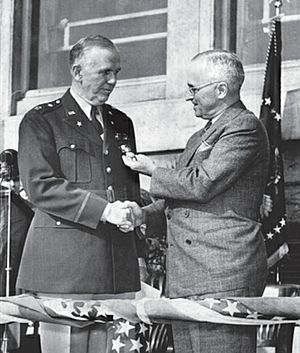
| U.S. Military Decorations | |
|---|---|
| Army Distinguished Service Medal with one Oak Leaf Cluster | |
| Silver Star | |
| Expert Rifleman Badge | |
| U.S. Service Medals | |
| Philippine Campaign Medal | |
| World War I Victory Medal with five campaign clasps | |
| Army of Occupation of Germany Medal | |
| American Defense Service Medal with Foreign Service Clasp | |
| American Campaign Medal (First recipient) | |
| World War II Victory Medal | |
| National Defense Service Medal | |
| Asiatic-Pacific Campaign Medal | |
| European-African-Middle Eastern Campaign Medal with two bronze service stars | |
| Mexican Border Service Medal | |
| Four Overseas Chevrons (for service in World War I) | |
| One Overseas Service Bar | |
| Foreign Orders | |
| Honorary Knight Grand Cross of the Order of the Bath (United Kingdom) | |
| Grand Cross of the Legion of Honour (France) | |
| Grand Cross of the Order of Military Merit (Brazil) | |
| Grand Cross of the Order of Merit (Chile) | |
| Grand Cross of the Order of Boyacá Cherifien (Colombia) | |
| Member 1st Class of the Order of Military Merit (Cuba) | |
| Member 1st Class of the Order of Abdon Calderon (Ecuador) | |
| Knight Grand Cross with swords of the Order of George I (Greece) | |
| Knight Grand Cross of the Order of Saints Maurice and Lazarus (Italy) | |
| Knight Grand Cross of the Order of the Crown of Italy (Italy) | |
| Grand Cross of the Order of Ouissam Alaouite (Morocco) | |
| Knight Grand Cross with swords of the Order of Orange-Nassau (Netherlands) | |
| Grand Officer of the Order of the Sun (Peru) | |
| Member 1st Class of the Order of Suvorov (Soviet Union) | |
| Foreign Decorations and Medals | |
| Croix de Guerre 1914–1918 with bronze palm (France) | |
| Medal for the Centennial of the Republic of Liberia (Liberia) | |
| Silver Medal for Bravery (Montenegro) | |
| Medal of Solidarity, 2nd Class (Panama) | |
| Queen Elizabeth II Coronation Medal (United Kingdom) | |
| Fourragère in the colors of the Croix de Guerre (France) | |
Civilian Honors
| Date | Awarding Organization | Award |
|---|---|---|
| 1943 | American Legion | Distinguished Service Medal |
| 1943 | Time magazine | Man of the Year |
| 1944 | Pennsylvania Society | Gold Medal for Distinguished Achievement |
| 1945 | Reserve Officers Association | Permanent Membership |
| 1945 | Theodore Roosevelt Association | Distinguished Service Medal of Honor |
| 1946 | United States Congress | Congressional Gold Medal |
| 1947 | Freedom House | Freedom Award |
| 1947 | Time magazine | Man of the Year |
| 1948 | Grand Lodge of New York | Distinguished Achievement Award |
| 1948 | Kappa Alpha Order | Award for Distinguished Achievement |
| 1948 | Variety Clubs International | International Humanitarian Award |
| 1949 | American Planning Association | Gold Medal |
| 1949 | New Orleans, Louisiana | Key to the City |
| 1949 | San Juan, Puerto Rico | Key to the City |
| 1949 | Fraternal Order of Eagles | National Civic Service Award |
| 1949 | New York Board of Trade | Award for distinguished service and contribution to the American way |
| 1949 | U.S. Conference of Mayors | Award for Distinguished Public Service |
| 1950 | Franklin Institute | Honorary Membership |
| 1950 | Youngstown, Ohio | Key to the City |
| 1950 | Disabled American Veterans, New York Chapter | Citizenship Award |
| 1951 | Commonwealth of Virginia | Virginia Distinguished Service Medal |
| 1952 | Four Freedoms Fund | Four Freedoms Fund Award |
| 1953 | Norwegian Nobel Committee | Nobel Peace Prize |
| 1954 | American Veterans | 10th Anniversary Award |
| 1956 | Woodrow Wilson Foundation | Award for Distinguished Service |
| 1957 | Organization for European Economic Cooperation | Silver Medal |
| 1957 | Commonwealth of Pennsylvania | Meritorious Medal |
| 1959 | Aachen, Germany | Charlemagne Prize |
| 1959 | Virginia Military Institute | New Market Medal |
Honorary Degrees
| Location | Date | School | Degree | Gave Commencement Address |
|---|---|---|---|---|
| 1934 | Command and General Staff College | Doctor of Philosophy (Ph.D.) | ||
| 1939 | Washington and Jefferson College | Doctor of Science (Sd.D) | ||
| 1940 | Pennsylvania Military College | Doctor of Military Science (DScMil) | ||
| 1941 | College of William and Mary | Doctor of Laws (LL.D.) | Yes | |
| June 15, 1941 | Trinity College | Doctor of Laws (LL.D.) | Yes | |
| 1942 | Norwich University | Doctor of Military Science (DScMil) | ||
| 1947 | Columbia University | Doctor of Laws (LL.D.) | ||
| February 22, 1947 | Princeton University | Doctor of Laws (LL.D.) | Yes | |
| June 6, 1947 | Harvard University | Doctor of Laws (LL.D.) | ||
| June 16, 1947 | Amherst College | Doctor of Laws (LL.D.) | Yes | |
| June 16, 1947 | Brown University | Doctor of Laws (LL.D.) | Yes | |
| 1947 | McGill University | Doctor of Laws (LL.D.) | ||
| 1947 | Lafayette College | Doctor of Laws (LL.D.) | ||
| 1947 | University of California | Doctor of Laws (LL.D.) | ||
| 1947 | University of London | Doctor of Laws (LL.D.) | ||
| November 11, 1947 | University of Oxford | Doctor of Civil Law (DCL) |
See also
 In Spanish: George Marshall para niños
In Spanish: George Marshall para niños
- German Marshall Fund
- George C. Marshall European Center for Security Studies
- George C. Marshall Foundation
- USS George C. Marshall (SSBN-654)
- Marshall Scholarship
- George C. Marshall's Dodona Manor
- George C. Marshall High School
- George C. Marshall Space Flight Center



